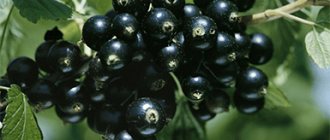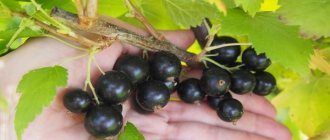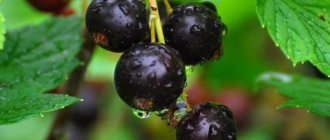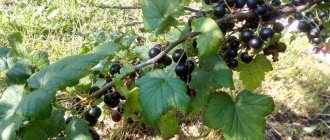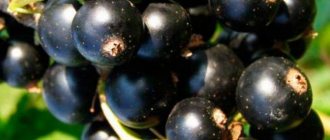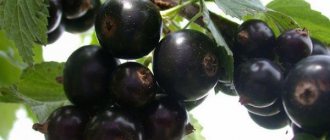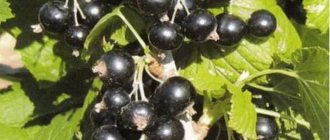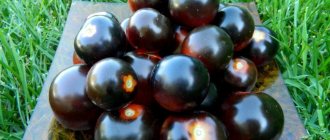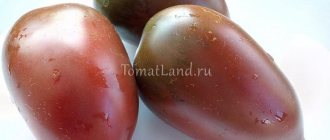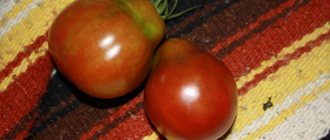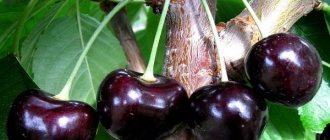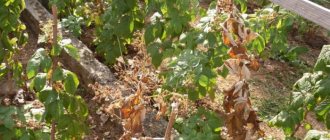History of variety selection
The originator of the Selechenskaya blackcurrant variety is A.I. Astakhov, who developed it in 1993 at the Bryansk Research Institute named after. Lupine based on samples of the Seyanets Golubki variety and line 32-77. The goal of the breeding work was to create a hardy species that can withstand both severe frosts and high temperatures, and also have good immunity to powdery mildew. Despite the fact that the goals of the project were fully achieved, work on this variety did not stop - soon after it was entered into the State Register, it was possible to develop black currant Selechenskaya 2, which, judging by the reviews, turned out to be even better.
Both varieties are recommended for cultivation in the Central and Northern regions of Russia.
Small purple kitchen
The eggplant color will fit harmoniously even in small kitchens of 5–10 sq.m.
It is important here not to overdo it with saturation. Don't choose a massive purple set
Purple inserts, open shelves, glass doors are what will make the furniture interesting and, at the same time, light.
Finishing is preferable in light colors. If you decorate one wall with purple against the background of white walls, the room will seem higher. The set is recommended to be tall, with good capacity, and made of lightweight materials. A good design option is a purple bottom and a light top. Open storage systems and glossy facades will add space.
Curtains on the windows will replace blinds, roller blinds, and Roman designs. Lighting should be as varied and bright as possible, but without bulky chandeliers.
Description of the Selechenskaya currant variety
Currant Selechenskaya is a slightly spreading bush of medium density, the height of which does not exceed 1.6 m. The shoots of the variety are light gray in color, and the branches are straight. Their surface is slightly pubescent. Each shoot produces at least 10 small white flowers.
Currant leaves are small, jagged at the edges and slightly convex. The description of the variety especially emphasizes the size of the Selechenskaya currant berries: large, round, they reach 2 cm in diameter and weigh up to 5 g. The skin of the berries is quite dense. The fruits are colored deep black.
The pulp of the berries is sweet, without a sour aftertaste. The sugar content of the variety is 7%, the acid content is 2%.
Harvest and storage
A special feature of these two varieties is the early ripening of the berries, which occurs in early to mid-July. Although Selechenskaya 2 has a larger berry, the yield per bush is higher for Selechenskaya, 5 kg versus 3. In both varieties, the berry is pulled off dryly, without damaging its surface
Therefore, the berry can tolerate transportation well, which is especially important for growing currants for sale. The taste sensations are very similar, the berries are sweet and aromatic, it’s not for nothing that they have almost the same excellent tasting scores
A ripe berry hangs on the bush for a long time without compromising its taste and aroma, so you can choose a sunny day for harvesting without haste. Currants can be stored in the refrigerator for up to one and a half weeks.
Berry preparations are traditional for black currants: jam, compotes, jelly from fresh berries with sugar, freezing. Currant leaves are used for pickling and pickling.
Jam is the most common blackcurrant preparation.
Characteristics of the variety
The Selechenskaya and Selechenskaya 2 species have been the undisputed leaders among currant varieties for many years. They gained particular popularity in the central part of Russia, in particular in the Moscow region.
Drought resistance, frost resistance
Currant bushes are characterized by good resistance to severe frosts - they can easily withstand temperatures down to –32°C. The plants' drought resistance has also received positive feedback from gardeners - the shrub feels good even in heat up to +35°C.
Productivity and fruiting
Black currants of the Selechenskaya and Selechenskaya 2 varieties ripen in early July. From each bush you can collect about 5 kg of berries.
Advice! It is better to pick berries in dry weather - this way the crop will remain fresh longer.
Area of application of fruits
Both varieties are great for canning, but their berries are just as suitable for fresh consumption. In addition, currants are used to prepare:
- baking;
- juices;
- jelly;
- guilt.
Resistance to diseases and pests
Black currant Selechenskaya and its subspecies are distinguished by good resistance to fungal diseases, however, the bushes are vulnerable to anthracnose and powdery mildew. The plant does not attract insects, except for aphids, but any insecticide can easily cope with them.
Advantages and disadvantages of the variety
The advantages of the variety include the following qualities:
- large fruit;
- sweet taste of berries;
- ability to withstand both very low and high temperatures;
- immunity to most fungal infections;
- ripe berries do not fall off the branches;
- consistently high yield with relative ease of care.
Obvious disadvantages include poor resistance to anthracnose and powdery mildew, as well as requirements for high levels of soil moisture.
Characteristics and description of plants
The Selechenskaya chokeberry variety has occupied a leading position among the preferences of gardeners, farmers and gardeners for many years. The berry crop is successfully cultivated both industrially and on private plots.
Bush and root system
Bushes of a hybrid variety of currant grow from 1.5 to 1.9 m, with straight branches of a grayish tint. The leaf blades are medium in size, matte, dark green in color, with serrated edges.
The root system is fibrous, superficial, and consists of two main processes up to 20 cm long and many small auxiliary ones. Due to the close location of the rhizomes, the shrubs are demanding on watering and fertilizing. At low winter temperatures, the roots of the plant provide additional insulation.
All about flowering and fruiting of the variety
Selechenskaya currant enters the flowering phase in mid-May. Cluster-shaped inflorescences form on the bushes, in which from 8 to 12 white flowers bloom, in place of which ovaries of berries are formed.
The first fruits ripen in mid-June. By the end of the season, from 2 to 4 kg of ripe berries are collected from each bush. The size of currant berries of the Selechenskaya variety varies from 1.5 to 3.5 g, and for the Selechenskaya 2 variety from 4 to 6 g.
The fruits are black in color with thin skin and sweet, aromatic pulp. The berries are used to make juices, nectars, jams, and added to confectionery and dairy products. Also, black currants retain all their beneficial properties and vitamins when frozen.
Important! The ripening of berries depends on the climatic conditions of the growing region. If in temperate latitudes black currant of the Selechenskaya variety ripens at the end of June, beginning of July, then in a northern climate the harvest occurs in August
Frost and drought resistance
Berry bushes tolerate spring frosts well even during the flowering period. Winter frosts are not dangerous for berry crops if there is snow and temperatures down to -30 degrees. Shrubs tolerate short-term drought well. If the bushes are not watered for a long time, the ripening berries fall off.
Immunity to diseases and insects
Proper and timely care of fruit bushes reduces the risk of plant infection with fungal viral infections, as well as pest attacks. The more carefully a fruit crop is cared for, the stronger its natural immunity develops.
What is the difference between Selechenskaya and Selechenskaya currants 2
Currant Selechenskaya 2 is very similar to its predecessor, but in many ways superior to it. It is less demanding in terms of self-care and bears larger fruits. In addition, the description of black currant variety Selechenskaya 2 states that its winter hardiness and drought resistance are also at a higher level. Finally, the plant practically does not suffer from powdery mildew and anthracnose, which often affect Selechenskaya blackcurrant bushes.
Otherwise, the two varieties are similar. The agricultural technology for planting and subsequent care for them is identical.
How to care for bushes?
We recommend reading our other articles
- Quail brooder
- Potato variety Tuleevsky
- Growing watermelons in a greenhouse
- Pig breeding
After Selechenskaya or Selechenskaya 2 currants are planted, they need to be provided with good care throughout the life of the bush. Then he will annually delight the gardener with abundant harvests.
- Watering is carried out once every 10 days.
A bush needs 0.5-1 bucket of water, depending on the type of soil. After Selechenskaya or Selechenskaya 2 currants are planted, they need to be provided with good care - Subcortex is applied in spring, summer and autumn - only 3 times. In the spring, before the buds open, you need to add 100 urea dissolved in a bucket of water. This amount is enough for 1 bush. During the period when the ovaries appear, the bushes are fed with 150 g of nitroammophoska dissolved in 10 liters of water. In the fall, before winter frosts, you need to add a bucket of humus with a glass of wood ash under each bush.
- Preventive spraying with fungicides and insecticides or any folk substances is carried out once every 2 months.
- Pruning is carried out every year so that there are not too many pagons. An adult bush that is more than 5 years old should have approximately 4-5 branches of different ages.
- Once every 10-12 years, the bushes are either transplanted to a new place or replaced with young ones. In this case, the new Selechenskaya or Selechenskaya 2 currants should also be planted in a new place where the currants did not grow previously.
- For the winter, the Selechenskaya 2 variety should be insulated. The ground is mulched, and the bush is wrapped in insulating material.
Rules for planting currants
When planting this crop, as a rule, there are no special difficulties. Nevertheless, compliance with certain rules of agricultural technology will allow you to fully realize the potential of this unpretentious shrub.
Recommended timing
Currant bushes are planted in autumn or spring, but when planted in autumn, the plants take root better. It is better to plant the variety in September - this way its root system will have time to get stronger before the first frost arrives.
Choosing a suitable location
Direct sunlight can cause leaf burn on plants, so currants are planted in partial shade or in an area with diffused light. In this case, it is better to choose places where the bushes will be reliably protected from strong winds.
Selechenskaya black currant does not have any special requirements for the type and quality of soil, but if desired, you can fertilize the soil before planting. To do this, add a mixture of nitroammophoska (100 g) and wood ash (200 g) to the soil, which is added with 1 bucket of garden soil.
Selection and preparation of planting material
When choosing seedlings, you should pay special attention to the condition of the roots. They should be thin, thread-like, not counting the two main, stronger ones. The above-ground part should not be damaged - the surface of a healthy plant is smooth to the touch. There should be no stains or plaque on the buds and leaves.
A dark cut indicates the plant’s weak immunity; it will often get sick. Healthy seedlings have a light cut with a green tint.
Landing algorithm
When planting currants, it is important to observe the recommended interval between planting holes. Bushes are planted at a distance of 2 m from each other. The optimal pit depth is 50 cm, diameter is 50-60 cm.
The landing procedure is as follows:
- The bottom of the dug hole is filled with a bucket of water.
- After the water has settled, the seedling is lowered into the hole. It is important to secure it in an inclined position. The root collar should be buried at least 5 cm.
- After the roots of the plant are straightened, the hole is filled with earth and lightly compacted.
- The currant bush is watered abundantly (10 liters of water is enough).
- When the moisture is absorbed, the area near the bush is mulched with sawdust or straw.
Important! Tilting the seedling at 45 degrees stimulates the growth of roots and buds, making the bush bear fruit better.
Growing
To successfully grow Selechenskaya blackcurrant, you need to carefully select seedlings.
- 1- or 2-year-old healthy, resilient seedlings without visible damage are suitable;
- Shoots from 40 cm in height and up to 8-10 mm in diameter at the base, with smooth bark and not withered leaves;
- The roots are dense, with two or three skeletal branches up to 15-20 cm, not dried out;
- If the seedlings are spring, they have swollen, large buds.
Site preparation
Currant Selechenskaya 2 grows well in partial shade and develops best in a place protected from strong air currents. The crop is planted along fences, buildings, on the south or west side of the garden. Loves neutral or low acidity soils. The distance to groundwater should be at least 1 m.
- Before planting the Selechenskaya black currant variety, the plot is fertilized 3 months in advance with humus, potassium sulfate or wood ash and superphosphate;
- If the soil reaction is acidic, apply per 1 square meter. m 1 kg of dolomite flour or lime.
Selechenskaya 2 currant bushes are placed 1.5-2 m from each other.
- If a cutting is planted, or the soil is heavy, then the seedling is arranged so that it is inclined at an angle of 45 degrees to the ground;
- The hole is filled in and compacted. Sides are made around the perimeter so that when watering, water does not leak beyond the projection of the hole;
- 20 liters of water are poured into the created bowl around the seedling and mulched.
Blackcurrant bushes Selechenskaya and Selechenskaya 2 need regular watering, especially in the third year, at the beginning of fruiting. Then the soil is loosened no deeper than 7 cm, removing all weeds.
- Typically, plants are watered 1-2 times a week or more often, based on the amount of natural precipitation, 1-3 buckets;
- Watering is increased in the ovary phase, after harvesting and before the onset of frost, no later than the beginning of October.
Care involves mandatory covering of young bushes for the winter.
Currant Selechenskaya and Selechenskaya 2 need timely feeding.
- In spring and autumn, the bushes are fed with a mullein solution diluted 1:4, or 100 g of bird droppings are diluted in 10 liters of water;
- In the 3rd year of growth, add 30 g of urea in the spring, and humus or compost to the mulch;
- In October, 30 g of superphosphate and 20 g of potassium sulfate are given to the bushes. Mulch with humus;
- If the soils are fertile, you can refuse autumn mineral products by adding 300-400 g of wood ash under the bush.
Read also: How to freeze basil for the winter at home in the freezer - Suseki
By forming a Selechenskaya 2 currant bush in spring or autumn, gardeners lay down the future harvest, which is created on shoots that take 2 or 3 years.
- Every year 10-20 zero shoots grow from the root, which become skeletal branches after a season;
- In the 2nd year of growth, 5-6 branches are left;
- To form branches, the tops of young shoots are pinched in July;
- In autumn, the branches are pruned in front of the outer bud by 3-4 eyes;
- Branches that are older than 5 years, dry and diseased are cut out.
Bushes of northern dessert fruits, shimmering in the summer with the black satin of ripe berries, will delight garden owners for a long time if they pay attention and love working on the land.
Aftercare for currants
These two varieties are quite unpretentious, but lack of moisture has a negative effect on currant pieces. The berries become smaller, and their taste loses its sugar content. Therefore, it is recommended to water currants abundantly - an average of 30 to 40 liters of water per 1 m2.
Plants are pruned in autumn or spring. Dry shoots can be removed throughout the year.
The features of pruning are described in more detail in the video below:
These varieties can be fed as desired. Nitrogen-containing and potassium fertilizers are best suited for this.
Despite the high frost resistance of Selechenskaya blackcurrant, reviews emphasize that it is better to cover young plants for the winter. To do this, the shoots must be tied together to reduce the risk of damage to the buds in the spring to a minimum - a strong wind can easily knock them down, swinging the branches.
Adult plants easily tolerate cold temperatures down to –32°C without shelter, but spring frosts can damage the bush. At this time, it is better to insulate it with agrofibre.
Advantages and disadvantages
Advantages
Currants please with a lot of advantages, which include:
- high resistance to any weather conditions;
- increased immunity to diseases and pests;
- excellent taste characteristics;
- high productivity;
- minimal care;
- high fruit strength;
- long shelf life;
- excellent presentation;
- transportation resistance.
Flaws
The culture has practically no disadvantages. The only thing that can be noted:
- the berries may become small if the plant is not fertilized;
- If the weather is rainy for a long time, the plant may be affected by anthracnose.
Methods for propagating currants
Currants are propagated by green and woody cuttings, which are planted in autumn or spring. Woody cuttings are collected in early December, and their length should be about 20 cm and their diameter should be 1 cm.
The next step is treating the planting material with paraffin. This procedure will ensure better moisture retention. Then the treated material is wrapped in damp paper and oilcloth, and then transferred to the refrigerator.
Attention! Both the bottom and top of the cuttings are covered with paraffin.
Diseases and pests, methods of control and prevention
Black currant Selechenskaya often suffers from anthracnose in rainy years, although in general the plant is quite resistant to fungal diseases. The infection appears in the form of brown spots that quickly cover the leaves and soon spread to the branches.
Prevention of anthracnose includes
- digging up the tree trunk circle in the spring months;
- timely removal of dry leaves and shoots from the bush and tree trunk;
- removing weeds near the bush.
If the plant is still affected by this disease, it is treated with any fungicide. During fruit set, it is better to use a solution of Bordeaux mixture.
Powdery mildew is another disease to which this variety is vulnerable. The first signs of damage to a bush are a gray coating on the leaves and branches, which soon begin to deform. In winter, the diseased bush dies.
Both chemicals and folk remedies can be used against powdery mildew. For example, a solution of soda and soap has worked well: 30 g of soda is mixed with 10 g of soap and diluted in 3 liters of water.
As a preventive measure it is recommended:
- do not overfeed the bushes with nitrogen fertilizers;
- monitor soil moisture - high humidity can trigger an outbreak of powdery mildew;
- avoid thickening of plantings.
Black currant Selechenskaya practically does not attract insects, but plants can be affected by aphids, which eat up the leaves in the shortest possible time.
To avoid this, you must:
- get rid of dry leaves and shoots in a timely manner;
- weeding;
- treat the bushes with boiling water in the spring.
When currants are infested with aphids, their bushes are treated with Actellik.
How to fight diseases
Columnar rust. With this disease, yellow spots appear on the surface of the leaf, and orange seals with a pale yellow tint grow on the underside. Methods of control: The use of one percent Bordeaux mixture or Nitrafen is required, according to the instructions. For prevention purposes, it is necessary to collect and burn leaves and loosen the soil around the bush.
Gray rot. This type of fungus leads to increased brown spotting of foliage. A gray coating forms in the berry clusters. To combat this disease, it is necessary to treat the bush and the soil around it with copper sulfate. For preventive purposes, it is recommended to treat with one percent Bordeaux mixture before bud break.
Anthracosis. It also refers to fungal diseases. When infected with anthracosis, the bark of the bush loses its elasticity and cracks. To combat it, currant bushes are treated with Cuprozan and Fthalan, strictly following the instructions.
